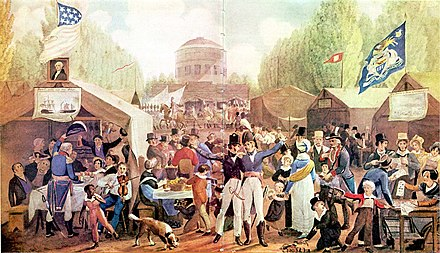The year was 1819, and the United States was riding high on what historians now call the “Era of Good Feelings.” President James Monroe, the latest in the so-called “Virginia Dynasty,” presided over a nation enjoying rapid economic growth. Industry and agriculture thrived, fueled by international demand for American goods. It seemed like nothing could go wrong—until everything did.
This was the Panic of 1819, America’s first major financial crisis. The bubble had burst, and the country found itself spiraling into economic chaos. But what caused this sudden collapse?

The Land Boom: Fueling the Fire
To understand the roots of the crisis, we must first examine America’s land policies. Following the War of 1812, both the United States and Europe were in recovery mode. The British Industrial Revolution had taken off, creating an enormous demand for raw materials—especially American cotton. At the same time, Europe had experienced several years of poor harvests, making American grain a precious commodity.
Meanwhile, the U.S. seemed like a paradise for immigrants fleeing overcrowded European cities, high taxes, and political oppression. With vast tracts of cheap, fertile land, America was the perfect destination for those dreaming of a fresh start. Between 1815 and 1819, immigrants arrived in droves, eager to stake their claim in the new world.
The Louisiana Purchase had added over 2 million square kilometers of land to the U.S., and the federal government was eager to sell it. Initially, Congress sold land in large tracts, favoring wealthy speculators who subdivided and resold it at a profit. But under pressure from voters, Congress lowered prices and reduced the minimum purchase size, making land affordable for nearly everyone.
The result? A speculative land-buying frenzy. Farmers, merchants, and dreamers alike borrowed money to buy as much land as possible, convinced that prices would only go up. By 1817, land debt had skyrocketed from $3 million to $17 million. The American economy wasn’t growing—it was inflating like a balloon. And as with all bubbles, it was only a matter of time before it popped.
Banking Gone Wild
At the heart of the crisis was a broken banking system. In 1811, the U.S. government had allowed the First Bank of the United States (the country’s central bank) to expire. Without a central authority regulating the money supply, hundreds of private banks sprang up across the country, freely issuing banknotes with little to no backing in actual gold or silver.
These banks were eager to lend, especially for land purchases. With so much easy credit available, speculation ran rampant. But in 1816, recognizing the need for financial oversight, Congress established the Second Bank of the United States. Its job was to bring order to the chaos—but instead, it made things worse.
At first, the Second Bank was just as reckless as the private banks, issuing its own banknotes and even getting involved in land speculation. But by 1818, the bank’s directors realized the economy was dangerously overheated. In a drastic move, they suddenly demanded that all debts be paid in gold and silver rather than paper money.
Panic ensued. Private banks, unable to meet these demands, collapsed. Businesses shut down, farmers lost their land, and thousands of Americans were thrown into financial ruin. By 1819, cities like Philadelphia and New York saw massive unemployment, while farmers in the West found themselves drowning in debt. The dream of endless prosperity had turned into a nightmare.
Lessons and Legacy
The Panic of 1819 was a harsh introduction to the boom-and-bust cycle of capitalism. For the first time, Americans experienced a modern financial crisis—one driven by speculation, banking mismanagement, and the harsh realities of international trade. It also planted the seeds of a long-standing distrust of banks, particularly the Second Bank of the United States, which would continue to be a political lightning rod until its ultimate demise under Andrew Jackson.
If this sounds familiar, it’s because history has repeated itself time and again—from the Great Depression of 1929 to the financial crisis of 2008. The Panic of 1819 serves as an early example of the risks inherent in unchecked speculation and the dangers of a poorly regulated financial system. While the players and details have changed, the fundamental lesson remains the same: when greed drives the economy, a crash is never far behind.
The Road to Recovery
The economic depression that followed the Panic of 1819 lingered for several years. The federal government made some efforts to ease the crisis, such as allowing debtors more time to pay off their land purchases. However, there was no structured bailout or safety net—unlike in modern financial crises. Instead, individuals and businesses had to claw their way back through hard work and financial prudence.
One lasting consequence of the Panic was a shift in political attitudes. Many Americans, particularly those in the West and South, began to view banks and the federal government with deep suspicion. This set the stage for the rise of Andrew Jackson, who rode a wave of populist anger all the way to the White House in 1828. His fierce opposition to the Second Bank of the United States was, in many ways, a direct response to the devastation of 1819.
Conclusion
The Panic of 1819 was America’s first financial disaster, but it wouldn’t be the last. It revealed the dangers of unregulated banking, rampant speculation, and economic policies that prioritized short-term gains over long-term stability. The lessons from this crisis remain relevant today, reminding us that financial bubbles are always followed by painful corrections.

No comments yet.